How much does Mateo Zielonka love pasta? Answer: a seemingly inexhaustible amount. He makes it for his day job at London’s 180 Studios, where he is head chef. He makes it for his wildly popular online accounts as the Pasta Man (also the name of his first of three pasta cookbooks to date).
You’d think that by the time he gets back to Dorset, where he lives, he’d be sick of the stuff, but no, he loves making it at home too. “I think I’m going to have pasta this evening,” he tells me cheerfully. “I eat it five, six days a week – in smaller portions, with green salad or some broccoli on the side, because it’s nice to have it with lots of vegetables.”
If there’s time, he makes fresh pasta, which he insists can be produced without breaking a sweat. “You can make the dough ahead and rest it,” he advises, “or freeze it in portions and defrost one overnight before rolling it out.” Even the initial kneading stage isn’t necessary if you have a food processor handy. But dried pasta works just as well. “The sauce is the main thing,” he says.
Zielonka’s new cookbook, Pasta Pronto, is full of clever, time-saving tips and delicious sauces, some requiring a shopping list and a spare half hour, others needing little more than the basics in the door of your fridge (butter and parmesan is all you need for fettucine alfredo).
His interest in pasta was seeded by watching The Sopranos as a teenager in Poland, but Zielonka only started making it in earnest eight or nine years ago. First, he bought a pasta roller and expanded his repertoire by studying photos online. Then he started posting videos to social media as a guide for others. His creative approach – weaving together multicoloured strands, creating ravioli imprinted with horses or Christmas trees – has won him fans around the world; now he’s nearing a million followers on both Instagram and TikTok.
For all the technical wizardry on his feeds, however, Zielonka counsels rookie pasta makers to keep it simple. “Perfect doesn’t exist,” he says. “Aim for rustic instead and don’t be afraid of making mistakes.”
One of the many reasons Zielonka loves pasta, in addition to it being simple, delicious, inexpensive and adaptable to whatever’s in your store cupboard, is that it’s relaxing to make – meditative even.
“I’ll put some music on and make pasta, and nothing else exists around me,” he says. “It’s a very good way to calm down after a busy day.”
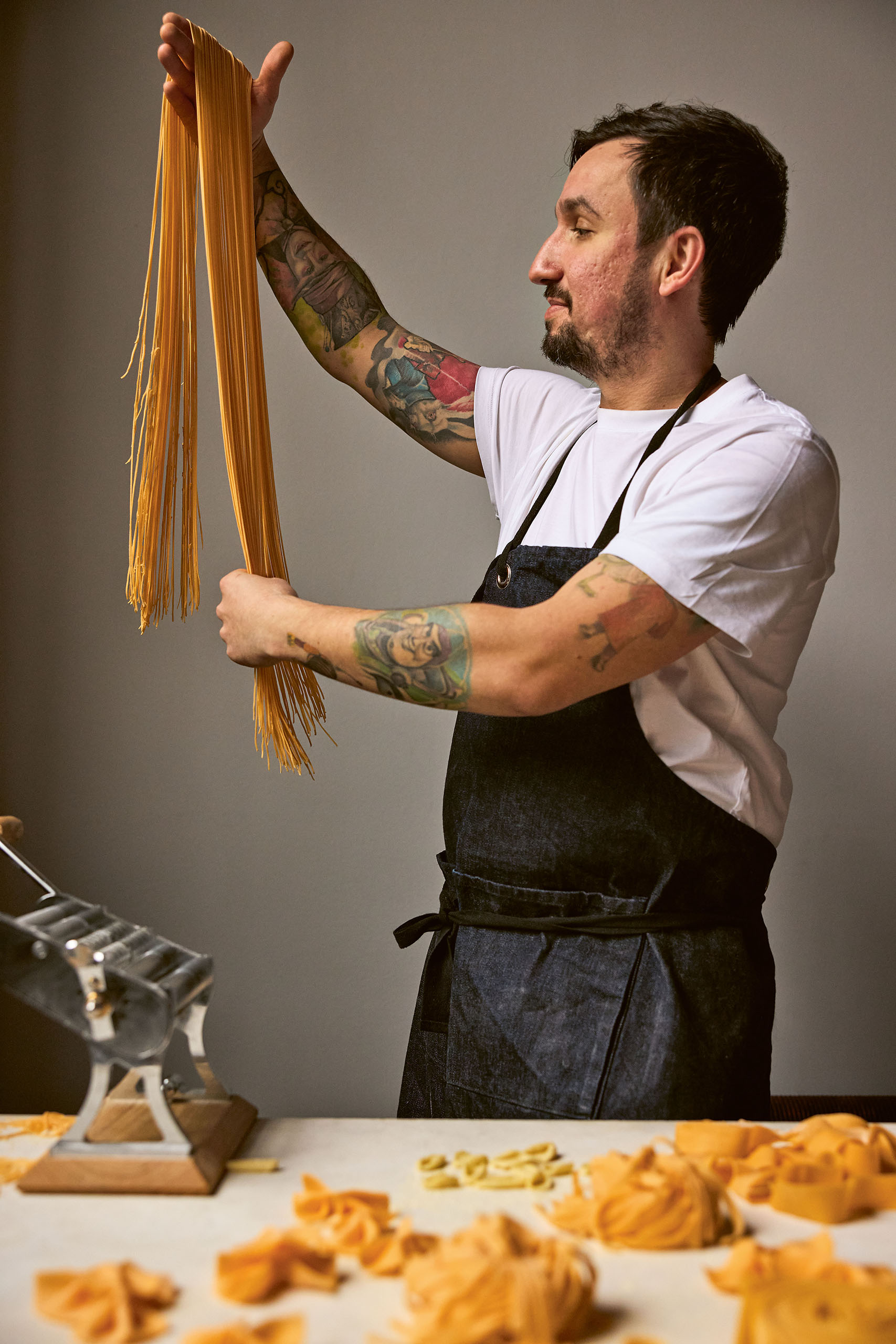 Spaghetti with squid, chilli and garlic
Spaghetti with squid, chilli and garlic
When on holiday in Italy, I am really drawn to eating seafood dishes, from refreshing crudo (dressed raw seafood) to calamari fritti (fried squid rings). It’s a real treat. I think of the Italian coast when I make this simple squid pasta. It’s especially easy to make if you buy cleaned squid at the supermarket or from your fishmonger. If you buy frozen squid, you will need to defrost it in the fridge overnight or remember to place it in the fridge in the morning before work.
olive oil 3 tbsp
garlic 3 cloves, finely diced
red chillies 2, deseeded and finely chopped
squid 450g, sliced into finger-sized pieces
cherry tomatoes 350g
dried spaghetti 360g, or 400g fresh
parsley 1 bunch (about 25g), leaves picked and chopped
lemon juice of ½
pangrattato to serve (see below)
Heat the olive oil in a large saucepan and fry the garlic for about a minute, then add the chillies. Continue to cook on a low heat for 2-3 minutes until fragrant.
Increase the heat to medium, add the squid and cook for 3 minutes, then add the tomatoes and cook for a further 3-4 minutes. Gently break the tomatoes with the back of a wooden spoon. Keep the sauce on a very low heat while you cook the pasta.
Bring a large pan of water to the boil before adding salt, then cook the spaghetti according to the packet instructions.
Lift the pasta out of the pan using kitchen tongs and add it to the sauce. Scatter over the parsley, add the lemon juice and toss everything together. You may need to add some more pasta cooking water to make sure the pasta is well coated with the sauce. Check the seasoning.
Divide between 4 plates and add a generous topping of pangrattato for a delicious crunch.
Spaghetti with poached cod, capers and lemon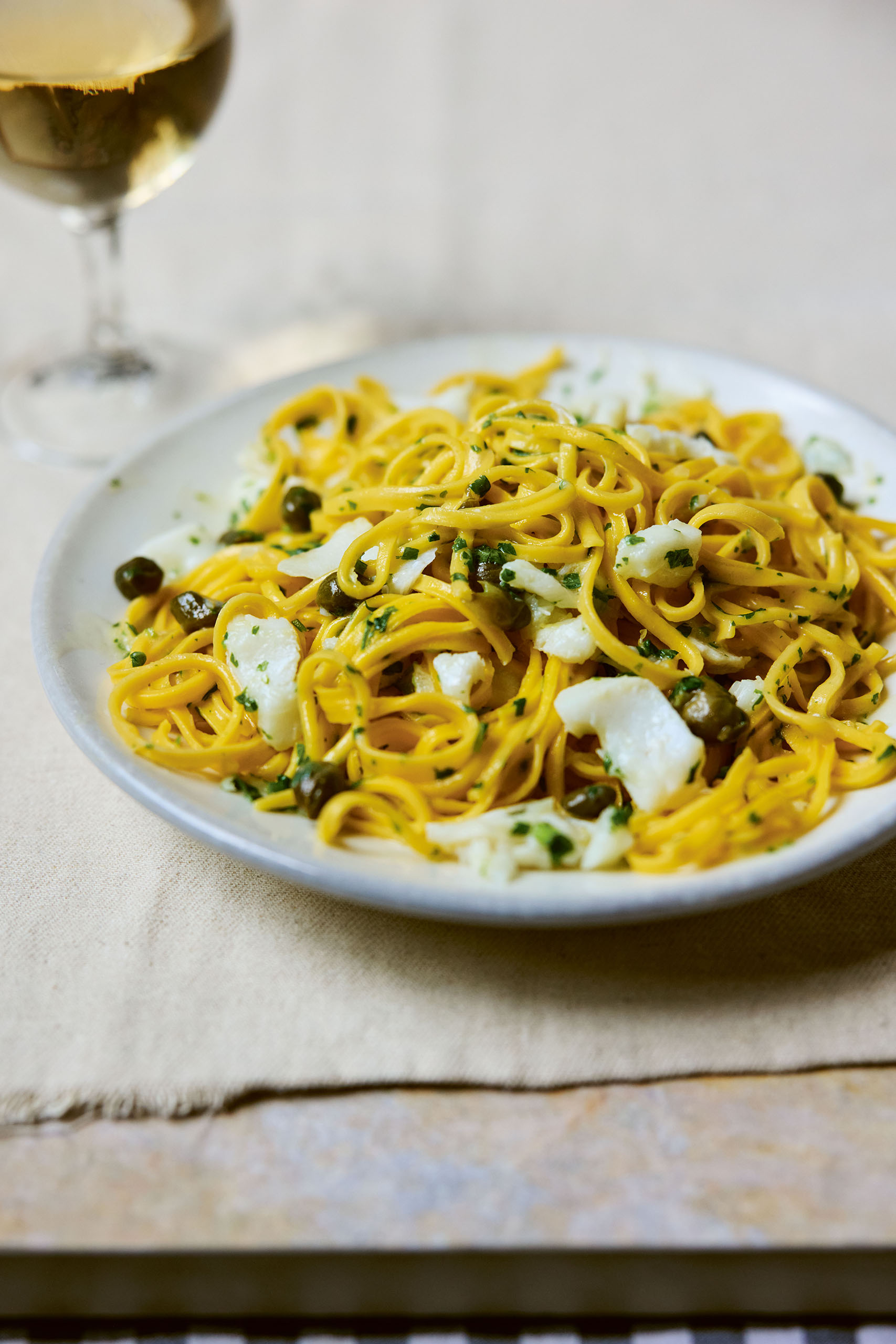
I live not far from the coast near a small harbour, where I love to watch the fishing boats heading out to sea or the fishermen cleaning their vessels after a productive trip. It looks like incredibly hard work, but I’m always grateful to be able to eat such fresh, locally caught fish. There is nothing better on a warm summer’s day than lightly poached cod, fragrant with lemon and garlic. The bonus here is that this is a simple and easy way to cook fish and you can’t really go wrong.
butter 75g
water 160ml
banana shallots 2, thinly sliced
garlic 2 cloves, thinly sliced
cod fillets 3-4 boneless, skinless (about 650-700g in total)
salted capers 3 tbsp, rinsed
lemons zest of 2, juice of ½
dried spaghetti 360g, or 400g fresh
parsley ½ bunch (about 15g), leaves picked and chopped
Place the butter and water in a large saucepan over a low heat and stir with a wooden spoon until the butter has melted. Add the shallots and garlic, and cook on a medium heat for a few minutes until soft but not browned. Add the fish fillets, then cover the pan with a lid and cook for 5 minutes. Remove the lid, add the capers and lemon juice and zest, stirring them into the sauce. Gently break the fish into smaller pieces with a wooden spoon – it will fall apart quite easily. Remove from the heat while you cook the pasta.
Bring a large pan of water to the boil before adding salt, then add the spaghetti and cook according to the packet instructions.
When the pasta is nearly ready, place the sauce back over a low heat, then use kitchen tongs to lift the pasta into the sauce. Scatter the parsley over the top and use the tongs to bring everything together. Season to taste and serve straight away with a glass of chilled white wine If you’d like something fresh alongside, then a rocket and shaved parmesan salad would be perfect.
Spaghetti alla tapenade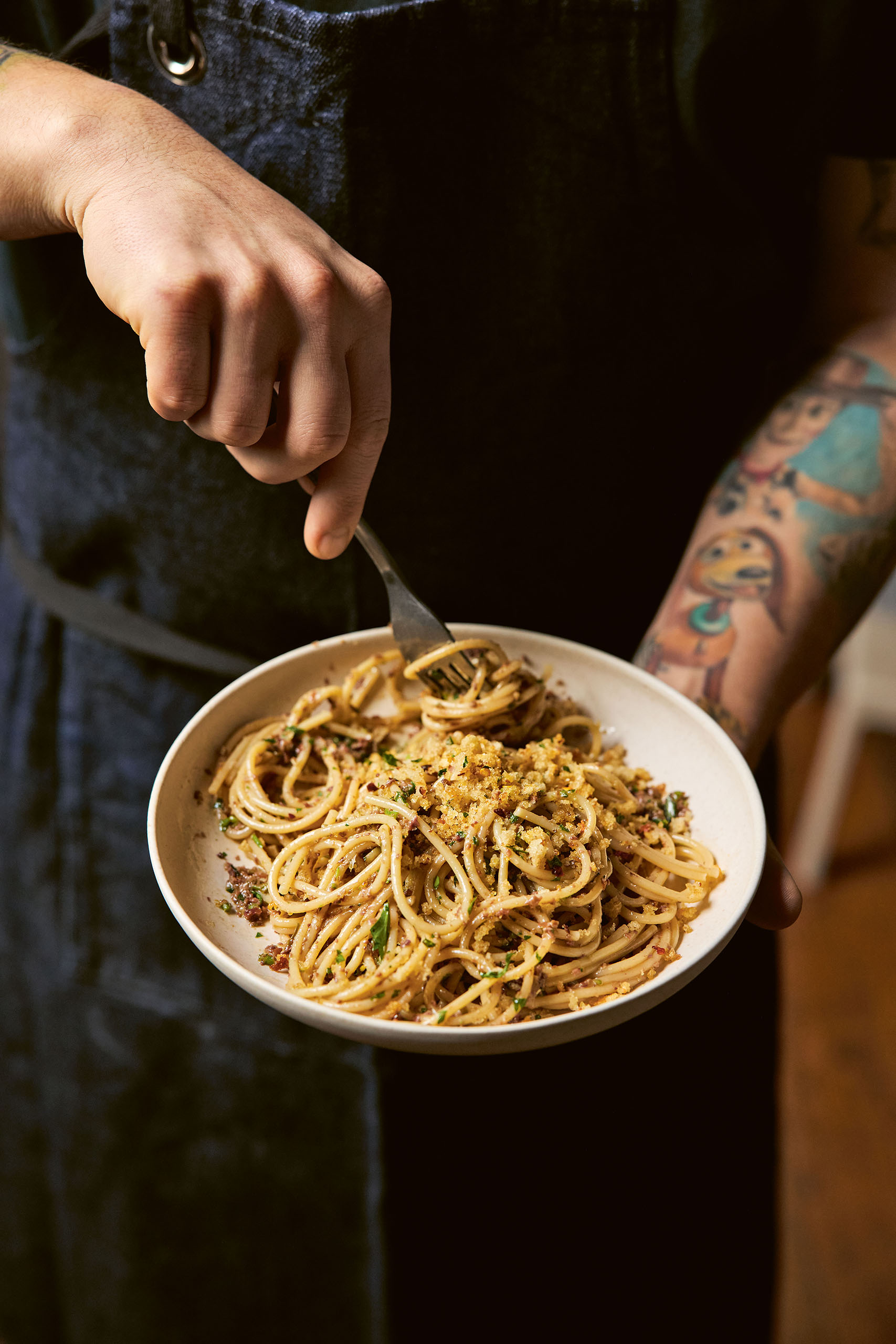
Inspired by a beautiful tapenade that one of our friends made recently, I came up with this tapenade sauce, which pairs perfectly with pasta. I buy olives from our local farm shop. There’s something so nice about scooping olives out of a large bowl into a container to take home – the next best thing to shopping in a Mediterranean market. Make sure you use good-quality olives and anchovies for this sauce as it really does lift the flavour. You will need a food processor for this recipe.
olive oil 90ml
kalamata olives 200g, pitted
anchovy fillets 6
salted capers 2 tsp, rinsed
lemon zest of 1, juice of ½
dried spaghetti 360g, or 400g fresh
garlic 2 cloves, finely chopped
parsley 1 bunch (about 25g), leaves picked and finely chopped
pangrattato 3 tbsp, or grated parmesan, to serve (see below)
Place half the olive oil in the bowl of a food processor, then add the olives, anchovies, capers, and lemon zest and juice, then pulse for 10-15 seconds until the ingredients are just chopped into little pieces (you don’t want a puree, but something with plenty of texture). Transfer the mixture to a small bowl.
Bring a large pan of water to the boil before adding salt, then cook the spaghetti according to the packet instructions.
Meanwhile, heat the remaining olive oil in a large saucepan. Add the garlic and fry for 30 seconds.
Use tongs to lift the spaghetti into the garlicky oil (it will carry some of the starchy pasta cooking water with it – just what you want). Toss the pasta in the garlicky oil, then add the tapenade and chopped parsley and swirl everything together, adding more pasta cooking water if the sauce needs to be loosened a little. Once the pasta is well coated in the sauce, season to taste with sea salt and freshly ground black pepper.
Serve straight away with plenty of parmesan or some delicious crunchy pangrattato. A bowl of green beans with lemon is good alongside. A glass of robust red wine is the perfect accompaniment, too.
Spaghetti with creamy ricotta and basil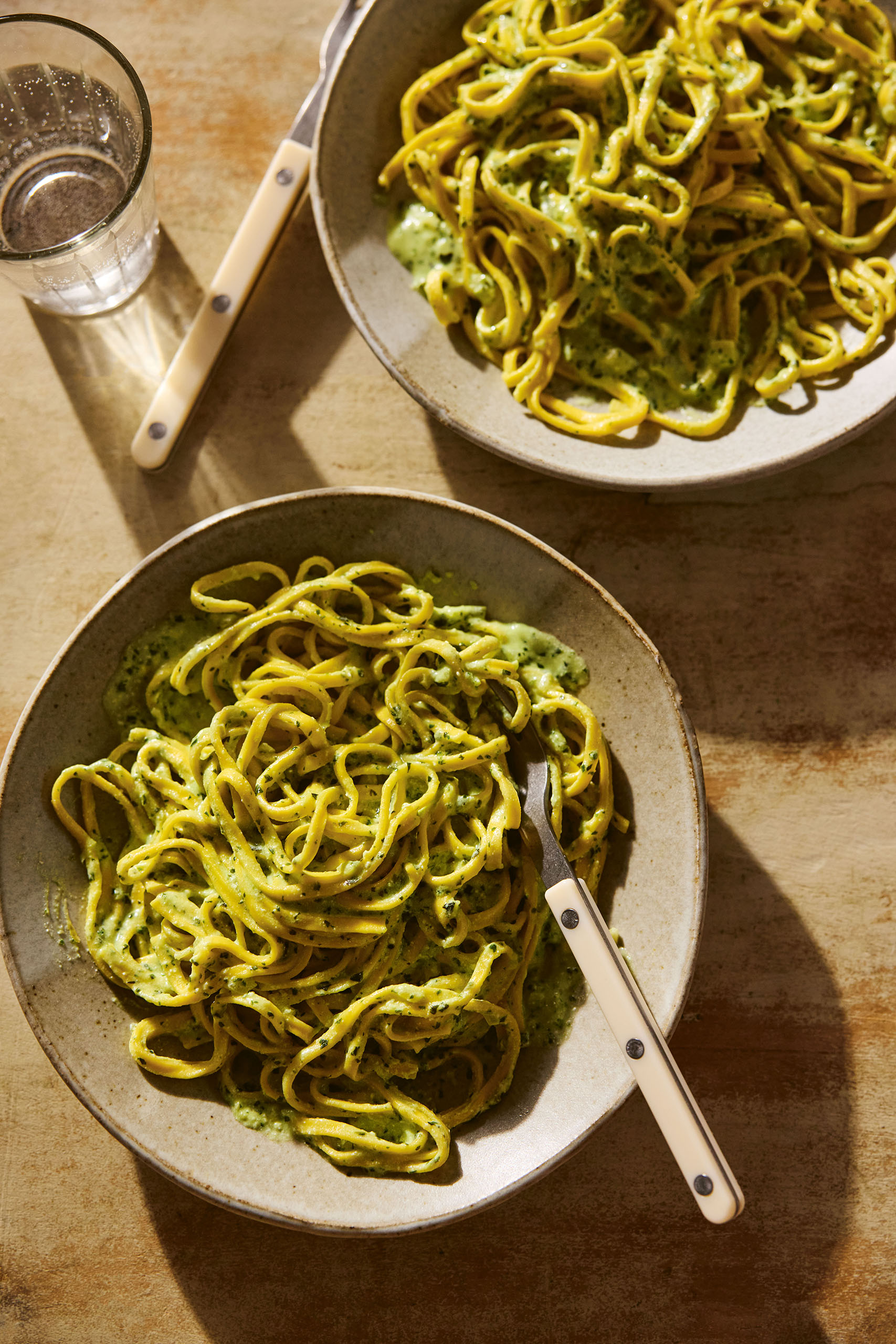
Ricotta makes a deliciously creamy yet light sauce, which is especially good when blended with fragrant basil leaves. Such a simple summer supper, served with a green leaf salad or a dish of shaved courgettes with basil and mint and a glass of chilled white wine.
olive oil 45ml
garlic 2 cloves, thinly sliced
shallots 2, thinly sliced
parmesan 55g (vegetarian, if necessary), grated
basil leaves about 25g
lemon zest of 1, juice of ½
ricotta 200g
dried spaghetti 360g, or 400g fresh
pangrattato (see below) to serve
Heat the olive oil in a large saucepan and fry the garlic and shallots on a medium heat until soft. This will take about 5 minutes. Set to one side.
Place the parmesan, basil leaves, and lemon zest and juice in the bowl of a food processor and blitz for 15-20 seconds until you have a thick paste. Transfer this mixture to a medium bowl, add the ricotta and use a wooden spoon to combine well. Season to taste with sea salt and freshly ground black pepper, then leave to one side while you cook the pasta.
Bring a large pan of water to the boil before adding salt, then cook the spaghetti according to the packet instructions.
Once the pasta is cooked, use kitchen tongs to transfer it to the saucepan of shallots, carrying over some of the starchy cooking water. Stir together well, then add the ricotta mixture and continue to stir. Loosen the sauce with extra pasta cooking water, if needed. Check the seasoning and serve in 4 warmed bowls, scattering a generous handful of pangrattato on top.
Pangrattato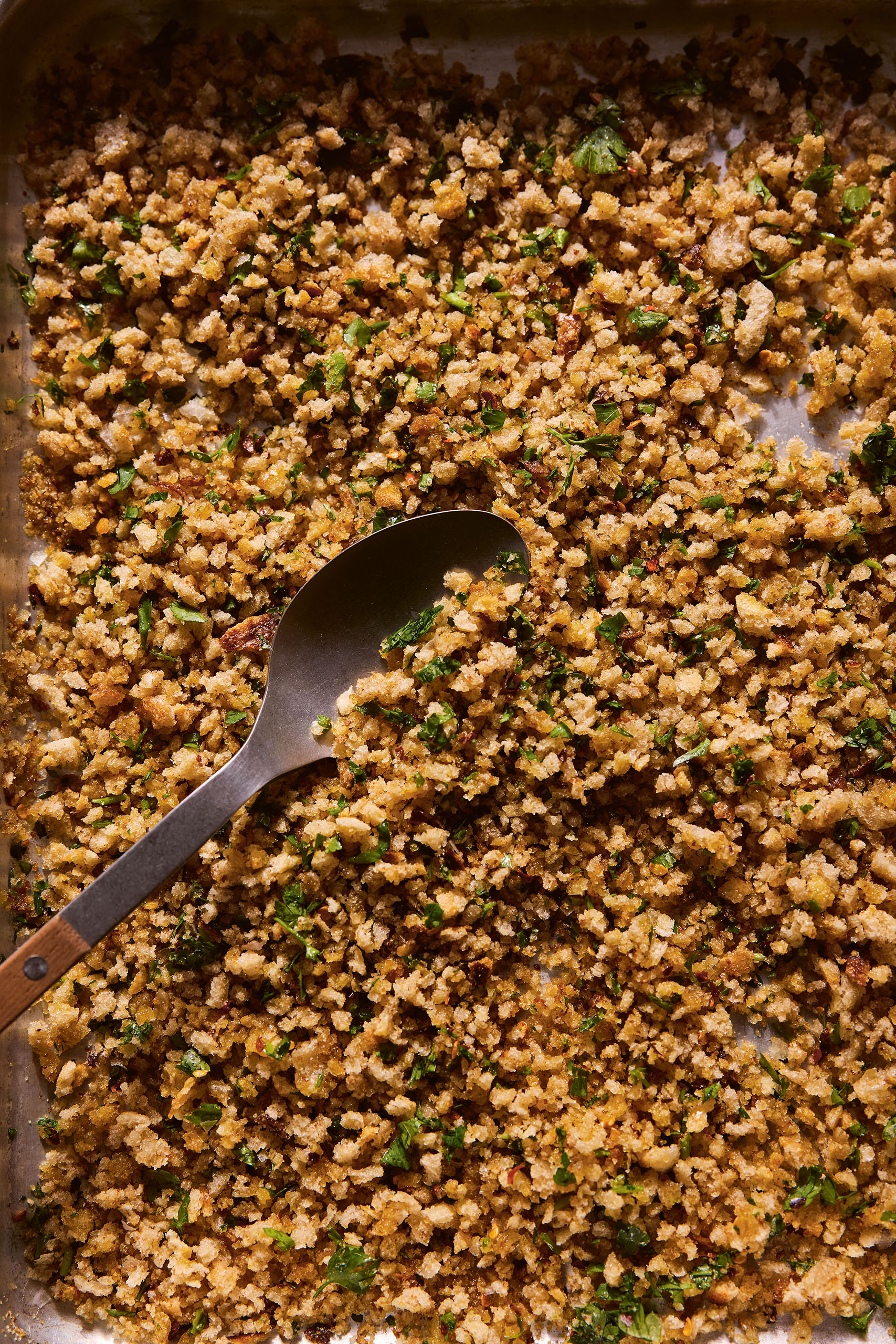
bread 4-5 slices, day-old
garlic 1 small clove
chilli (hot pepper) flakes ½ tsp
olive oil 1 generous tbsp
sea salt flakes
chopped parsley 1 tbsp
To make the pangrattato, preheat the oven to 160C fan/gas mark 4.
Tear the bread into pieces and arrange on a baking tray. Place in the oven for 20 minutes. After this time, the bread should have toasted nicely and be completely dried out. Don’t be hasty and add any olive oil at this stage, as the bread won’t stay crisp, which is what you really want. Remove the tray from the oven and allow the bread to cool completely.
Add the cooled bread to the bowl of a food processor or mini chopper along with the remaining ingredients and blitz everything together to make crumbs.
Store the pangrattato in an airtight container – not in the fridge – for up to two weeks. Scatter over soups, salads or any bakes such as cauliflower cheese, as well as using it as a topping for your pasta.
Easy tips to make great pasta
Use a food processor
People say you must knead the pasta dough for 10 minutes. It’s the classic way, but if you have a food processor, you can tip in the flour and egg, blitz it for 10 or 15 seconds and combine it with your hands, then rest it for half an hour and you’re ready to roll.
Get the seasoning right
It is the most important thing. When I do teach classes, people add tiny pinches of salt as if it is poison. Don’t be shy, season properly.
Don’t throw out the water
Pasta cooking water is very important because it’s full of starch. Add some to your sauce to loosen it, and it will help the sauce to bind to all the pasta strands.
Be adventurous
Don’t be afraid to experiment. Adapt recipes – we all like different levels of spice, saltiness and sourness. If you make a mistake, it can usually be fixed – balsamic vinegar can add sweetness to a sour tomato sauce, while a knob of butter can soften it.
Raid your cupboard
If you keep simple ingredients in the store cupboard, you can make a speedy supper. I always have dried pasta, olive oil, garlic, lemons and parmesan. A jar of anchovies in olive oil, a tin of Italian tomatoes and a jar of chickpeas will all give you options to make a quick pasta sauce.
Pasta Pronto: Simple, Speedy Recipes to Make Again and Again by Mateo Zielonka (Quadrille, £18) is published on 28 August. Order a copy at observershop.co.uk for £16.20


Dining and Cooking